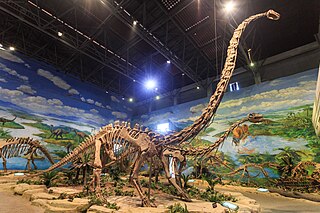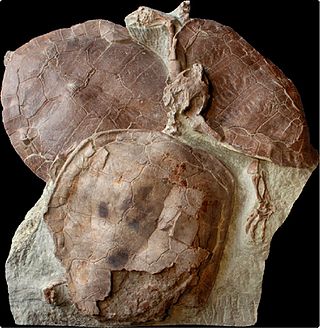
Siamotyrannus is a genus of theropod dinosaur from the early Cretaceous of Thailand.

Siamosaurus is a genus of spinosaurid dinosaur that lived in what is now known as China and Thailand during the Early Cretaceous period and is the first reported spinosaurid from Asia. It is confidently known only from tooth fossils; the first were found in the Sao Khua Formation, with more teeth later recovered from the younger Khok Kruat Formation. The only species Siamosaurus suteethorni, whose name honours Thai palaeontologist Varavudh Suteethorn, was formally described in 1986. In 2009, four teeth from China previously attributed to a pliosaur—under the species "Sinopliosaurus" fusuiensis—were identified as those of a spinosaurid, possibly Siamosaurus. It is yet to be determined if two partial spinosaurid skeletons from Thailand and an isolated tooth from Japan also belong to Siamosaurus.

Kinnareemimus is a genus of ornithomimosaurian theropod dinosaur from Thailand. It is known only from incomplete remains discovered no later than the early 1990s that includes vertebrae, partial pubic bones, metatarsals, and an incomplete fibula. The third metatarsal exhibits a distinctive lateral "pinching", known as the "arctometarsalian" condition, variations of which are found in ornithomimosaurs, tyrannosauroids, troodontids, and caenagnathids. Its remains were collected from the Early Cretaceous Sao Khua Formation, dating to the Barremian stage, at Phu Wiang, Khon Kaen Province. Its early occurrence makes it among the earliest ornithomimosaur known, depending on the age of the formation. Buffetaut et al. suggest the fossils of Kinnareemimus may indicate an Asian origin for advanced ornithomimosaurs.

Phuwiangosaurus is a genus of titanosaur dinosaur from the Early Cretaceous (Valanginian-Hauterivian) Sao Khua Formation of Thailand. The type species, P. sirindhornae, was described by Martin, Buffetaut, and Suteethorn in a 1993 press release and was formally named in 1994. The species was named to honor Princess Maha Chakri Sirindhorn of Thailand, who was interested in the geology and palaeontology of Thailand, while the genus was named after the Phu Wiang area, where the fossil was discovered.

Stupendemys is an extinct genus of freshwater side-necked turtle, belonging to the family Podocnemididae. It is the largest freshwater turtle known to have existed, with a carapace over 2 meters long. Its fossils have been found in northern South America, in rocks dating from the Middle Miocene to the very start of the Pliocene, about 13 to 5 million years ago. Male specimens are known to have possessed bony horns growing from the front edges of the shell and the discovery of the fossil of a young adult shows that the carapace of these turtles flattens with age. A fossil skull described in 2021 indicates that Stupendemys was a generalist feeder.

Cearachelys is an extinct genus of pleurodiran turtle which existed some 110 million years ago. The genus is monotypic, with only type species Cearachelys placidoi known.

Paleontology or palaeontology is the study of prehistoric life forms on Earth through the examination of plant and animal fossils. This includes the study of body fossils, tracks (ichnites), burrows, cast-off parts, fossilised feces (coprolites), palynomorphs and chemical residues. Because humans have encountered fossils for millennia, paleontology has a long history both before and after becoming formalized as a science. This article records significant discoveries and events related to paleontology that occurred or were published in the year 2009.

Mamenchisauridae is a family of sauropod dinosaurs belonging to Eusauropoda known from the Jurassic and Early Cretaceous of Asia and Africa. Some members of the group reached gigantic sizes, amongst the largest of all sauropods.
Basilochelys is an extinct genus of land turtle which existed during the early Cretaceous period (Berriasian). Containing the sole species Basilochelys macrobios, its fossils have been found in the Phu Kradung Formation of Northeast Thailand. It is considered to be the most basal member of the group Trionychoidae.

The Early Cretaceous Phu Kradung Formation is the lowest member of the Mesozoic Khorat Group which outcrops on the Khorat Plateau in Isan, Thailand. This geological formation consists of micaceous, brown to reddish-brown siltstone beds with minor brown and grey shale and sandstone beds. Occasional lime-noduled conglomerate occurs.
Sunosuchus is an extinct genus of goniopholidid mesoeucrocodylian. Fossils are known from China, Kyrgyzstan, and Thailand and are Jurassic in age, although some may be Early Cretaceous. Four species are currently assigned to the genus: the type species S. miaoi and the species S. junggarensis, S. shartegensis, and S. shunanensis. All species are from China. Goniopholis phuwiangensis, also from Thailand, was reassigned to Sunosuchus by Andrade et al. (2011). The material from Kyrgyzstan has not been assigned to any species.

Chalawan is an extinct genus of pholidosaurid mesoeucrocodylian known from the Late Jurassic or Early Cretaceous Phu Kradung Formation of Nong Bua Lamphu Province, northeastern Thailand. It contains a single species, Chalawan thailandicus, with Chalawan shartegensis as a possible second species.

Macrobaenidae is an extinct family of turtles, known from the Early Cretaceous to Paleogene of Laurasia. Their relationships to other turtles and whether they form a monophlyletic group are controversial. They are typically interpreted as stem or crown group cryptodires, but some more recent analyses have found them to lie outside crown group Testudines. Macrobaenids can be distinguished from other testudinatans by the presence of a carotid fenestra, cruciform plastron with strap-like epiplastra, and a lack of extragulars.

Xinjiangchelyidae is an extinct family of turtles known from the Lower Jurassic to the Middle Cretaceous of Asia and western Europe. They have generally been interpreted as either being basal cryptodires or placed outside of crown Testudines.

Basilemys is a large, terrestrial nanhsiungchelyid turtle from the Upper Cretaceous of North and Central America. Basilemys has been found in rocks dating to the Campanian and Maastrichtian subdivisions of the Late Cretaceous and is considered to be the largest terrestrial turtle of its time. In an analysis made by Sukhanov et al. on a nansiunghelyid turtle from the Upper Cretaceous of Mongolia, it was demonstrated that Asian nanhsiungchelyids gave rise to the North American nanhsiungchelyids.
Varavudh Suteethorn, or Warawut Suteethorn is a Thai palaeontologist and geologist. He is the current director of the Palaeontological Research and Education Centre, Mahasarakham University. He is best known for his work on vertebrate paleontology in northeastern Thailand, having contributed to the discovery of many fossil taxa and dig sites in the Khorat Plateau, as a part of a long-standing collaboration between Thai and French scientists.
Anatolemys is an extinct turtle genus in the family Macrobaenidae. Two species are known, both of which lived in the Late Cretaceous. Fossils were discovered in the Yalovach Formation of Tajikistan, the Kulbikin Member and Khodzhakul and Bissekty Formations of Uzbekistan and the Bostobe Formation of Kazakhstan. With 70 cm (2.3 ft) in carapace length, Anatolemys maximus was one of the three largest macrobaenids along with Early Cretaceous Yakemys multiporcata and Paleocene Judithemys backmani.

Phuwiangvenator is an extinct genus of megaraptoran theropod that lived during the Early Cretaceous period in what is now Thailand. It contains only the type species, P. yaemniyomi. The generic name of Phuwiangvenator comes from the Phu Wiang mountains, where the holotype was discovered, and the Latin word "venator" meaning hunter. The specific name, "yaemniyomi", is in honor of Sudham Yaemniyom, who was a historical paleontologist from Thailand and the first person to discover fossils there.

Indosinosuchus is a genus of teleosaurid neosuchian that lived during the Late Jurassic or Early Cretaceous in what is now Thailand. It contains two species, the type species I. potamosiamensis and I. kalasinensis, both recovered from the lower Phu Kradung Formation. It is unique among teleosauroids as it is the only named genus known from a freshwater environment, while most other members of the group are marine. Indosinosuchus is placed in the family Teleosauridae, but has a relatively robust skull that bears resemblance to members of the Machimosauridae. Biomechanical analysis of its mandible and teeth suggest that it would have had a substantial bite force comparable to animals like Lemmysuchus. The two Indosinosuchus species however differ in the speed at which they could open and close their jaws, impacting their respective ecology and possibly explaining how they coexisted in the same environment. All known specimens of this genus were recovered from a single locality, which has been interpreted as a mass death site, possibly caused by a drought or flash flood. The precise age of Indosinosuchus is unclear, as the vertebrate fossils of the Phu Kradung Formation support a Late Jurassic age, while palynological data suggests an Early Cretaceous (Berriasian) age.

Minimocursor is a genus of basal neornithischian dinosaur from the Late Jurassic Phu Kradung Formation of Thailand. The type species is Minimocursor phunoiensis.


















